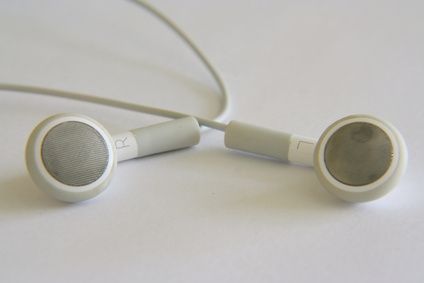
Not our intention to be a buzz kill. We love our music. It defines our memories, our generation, and can, as they say tunes “soothe the savage beast.” No matter what style you listen to, face it: We need tunes.
But, from back in the day of the birth of rock ‘n roll and live concerts, getting too close to the speakers will ultimately cause you to pay the piper.
And nowadays it’s no different. Look around. People are plugged-in to their gizmos using earbuds. This could lead to you muttering “What did you say?” cupping your hand to you hearing hole at an early age.
The Research Is In
Eggheads at the United Kingdom’s University of Leicester have given us another reason to crank it down when it comes to sticking tiny, sound translators into your ears. It’s not a new discovery. But it does stack further evidence on those who are listening to their music too loud using earbuds.
The latest studies say that turning-it-up over 110 decibels has the potential to give you this affliction called tinnitus. You know what that is?
According to Wikipedia, it’s defined as:
“Tinnitus can be perceived in one or both ears or in the head. It is usually described as a ringing noise, but in some patients, it takes the form of a high-pitched whining, electric buzzing, hissing, humming, ringing or whistling sound. Or as ticking, clicking, roaring, “crickets” or “tree frogs” or “locusts (cicadas) in your head.” Tunes, songs, beeping, sizzling, sounds that slightly resemble human voices or even a pure steady tone like that heard during a hearing test. In some cases, pressure changes from the interior ear. It has also been described as a “whooshing” sound because of acute muscle spasms, resembling wind or waves. Tinnitus can be intermittent, or it can be continuous, in which case it can be the cause of great distress. In some individuals, the intensity can be changed by shoulder, head, tongue, jaw or eye movements.”
Ouch! You want that?
In Most Cases The Gadget Handles This
Generally, most mp3 players won’t go higher that 110 decibels. Still, you need to slide it down to a much lower volume. Listening to anything at 110 decibels is like standing behind a jet engine on the runway. That’s why when you look out the window before taking a flight to fancy, everyone on the runway is wearing noise-cancelling head phones. Sure, you’re in a noisy place. However, trying to drown-out the racket with something louder is like fighting fire with fire.
Here’s what one of the people involved in the research had to say:
“We now understand why hearing loss can be reversible in certain cases,” Dr. Martine Hamann at the University wrote in a statement. “We showed that the sheath around the auditory nerve is lost in about half of the cells we looked at, a bit like stripping the electrical cable linking an amplifier to the loudspeaker. The effect is reversible and after three months, hearing has recovered and so has the sheath around the auditory nerve.”
You still have time to correct your evil ways.
Our Recommendations
Before you experience any temporary loss of your sound senses, we think you should consider these things:
- If you can’t hear anyone talking around you, the volume is too high.
- Experience any ringing in your ear after you remove the earbuds? You’ve gone overboard.
- Keep your mp3 player at around 60-percent of full blast.
Listen to us and you’ll thank yourself that you’ll be able to hear a pin drop when you’re a senior citizen.

